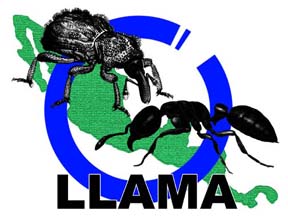
 |
LEAF LITTER ARTHROPODS OF MESOAMERICA (LLAMA) |
LLAMA student participant Crystal Vincent (2009, Guatemala) wins prestigious 2010 L’Oreal Canada Women in Science Mentor Fellowship!
Project LLAMA featured on LiveScience!
Overview of ant fauna in Costa Rica, Guatemala, and Chiapas.
2011 LLAMA expeditions in Nicaragua.
2010 LLAMA expeditions in Honduras.
2009 LLAMA expeditions in Guatemala.
2008 LLAMA expeditions in Chiapas, Mexico.
Preliminary results for Chiapas baiting samples.
Ants of Honduras.
Ants of Guatemala.
Ants of Chiapas.
Results of 2007 Reconnaissance trip to Chiapas and Guatemala.
Terrestrial arthropods make up a large fraction of global biodiversity but are among the least known of multicellular organisms. In the American tropics, Costa Rica has been a focus for inventory effort on a wide variety of arthropods (INBio, Project ALAS), but we remain ignorant of biodiversity patterns at larger spatial scales. In particular we know very little of species richness, degrees of endemism, and patterns of faunal turnover across the rest of Mesoamerica, a region scientists have long recognized as one of the most biogeographically interesting and imperiled landscapes on the planet. LLAMA is a program of arthropod sampling that will build on Costa Rican knowledge and extend it from Nicaragua to southern Mexico, in both lowland and highland areas. The sampling from highland areas is particularly important since these are known to be conservation priorities because of high endemism levels and vulnerability to global warming.
LLAMA will focus on two signature taxa - ants (Formicidae) and weevils (Curculionidae) - and one subcomponent of tropical forest ecosystems - the leaf litter layer of the forest floor. Ants and weevils are diverse, are important in ecosystem-level processes, represent different trophic guilds, have a well-developed taxonomic infrastructure on which to build, and have a large user community among ecologists and evolutionary biologists. Forest floor leaf litter is an easily sampled zone of concentrated biodiversity. Over 60% of total ant diversity and numerous poorly-known but diverse radiations of weevils live in this thin layer at the interface of soil and vegetation. It is an important zone for carbon movement, where carbon is either respired or stored in the soil, and litter arthropods play an important role in litter decomposition and dynamics.
Following reconnaissance and initial taxonomic work in year 1, LLAMA will sample four regions over four years: southern Mexico, Guatemala, Honduras, and Nicaragua. Each year the project will sample three mountains or mountain ranges, with low, medium, and high elevation sites on each mountain. At each site two plots will be sampled, one in mature and one in secondary forest. Each plot will be sampled with a combination of quantitative methods that allow diversity analysis and non-quantitative methods that maximize species capture. Each year there will be a 6-week field season, followed by 2-weeks of sample processing, workshops, and lectures at a Latin American host institution. The field crew will consist of graduate and undergraduate students from both PI and host institutions. All ants and weevils will be sorted and non-focal taxa will be distributed to collaborating taxonomists. At the end of the project, prepared specimens will be distributed to host institutions and other research collections.
All specimen data will be made electronically available. Each year all species and morphospecies of Formicidae and Curculionidae will be reported on-line, complete with Automontage images. For ants, special emphasis will be placed on the systematics of the hyperdiverse taxa Pheidole and Dacetini, and a thorough revision and molecular phylogenetic analysis of Mesoamerican Stenamma. For weevils the focus will be on members of the Lymantini, including descriptions of a number of known new generic lineages, and a thorough revision and phylogenetic analysis of the cryptorhynchine genus Tylodinus.
Broader impacts of the project are in education, international collaboration and development, and biodiversity conservation. Each year an international team of students will be immersed in a field experience with taxonomists, encouraging their development through training, inspiration, guidance, and social networks. Two PhD candidates will receive support and training for their research programs. PI's Longino and Anderson, in conjunction with collaborators from Latin American host institutions, will plan and deliver lectures and workshops each year during the sample processing time, fostering international scientific ties that will greatly benefit global biodiversity science. The scientific research in reserves and remaining forest patches will raise their status as sites that can attract economic activity, and the results on species turnover and endemism will inform conservation decisions and highlight the biotic importance of Mesoamerican cloud forests.

|
The Evergreen State College is a public, liberal arts college serving Washington state with a total undergraduate enrollment of approximately 4,100 students. There are three graduate programs offering master's degrees in Environmental Studies, Public Administration and Teaching. There are approximately 300 graduate students. The 1,000-acre, forested campus is in Olympia, Washington—one hour south of Seattle and two hours north of Portland, Oregon. |
|
|
The Canadian Museum of Nature in Ottawa is home to one of the world's largest and finest natural history collections. Comprised of 24 major science collections of more than 10 million specimens, the Museum's holdings cover four billion years of Earth history. |
|

Mexico: El Colegio de la Frontera Sur, ECOSUR, San Cristobal de las Casas, Chiapas (http://www.ecosur.mx/). ECOSUR is a postgraduate institution of multidiscplinary research and education in the southern border regions of Mexico. There are three speciality areas of study, one of which is biodiversity conservation.
Expedition Year: 2008.
Collaborator: Dr. Jorge Leonel León Cortés, Lepidoptera biodiversity and systematics; conservation biology of fragmented habitats.
E-mail: jleon@sclc.ecosur.mx

Guatemala: Universidad del Valle, Guatemala City (http://www.uvg.edu.gt/), and Universidad de San Carlos de Guatemala (http://www.usac.edu.gt/). UVG and USAC are the main institutions of advanced learning in Guatemala. The UVG Department of Biology has a focus on insect biodiversity and systematics. USAC has an active biodiversity research group and plays a key role in managing natural areas in the country.
Expedition Year: 2009.
Collaborator: Dr. Jack Schuster, Biodiversity, systematics and evolution of Passalidae (Coleoptera).
E-mail: jschuste@uvg.edu.gt
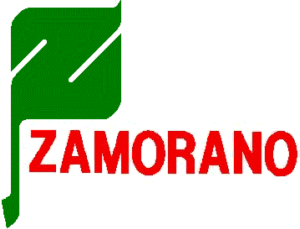
Honduras: Zamorano Biodiversity Center (Centro Zamorano de Biodiversidad), Pan-American School of Agriculture, Zamorano (http://www.zamorano.edu/). The Pan-American School of Agriculture is an internationally recognized and accredited institution dedicated to the responsible management of natural resources. It is the home of the Zamorano Biodiversity Center, a major biodiversity resource for Central America.
Expedition Year: 2010.
Collaborators: Dr. José Manuel Mora Benavides, Administrator at Centro Zamorano de Biodiversidad, and Dr. Oliver Schlein, Curator of the Insect Collection.
E-mail: jmora@zamorano.edu, oschlein@zamorano.edu

Nicaragua: Museo Entomologico, Leon (http://www.bio-nica.info/topic/index.html).
Expedition Year: 2011.
Collaborator: Dr. Jean-Michel Maes, Biodiversity and systematics of insects, Curator of insect collection.
E-mail: jmmaes@ibw.com.ni
Bulk samples of non-focal taxa will be distributed to five taxonomic collaborators. They will maintain a distribution network for material. If you have questions about access to this material, please contact the collaborator directly.
Arachnida, Myriapoda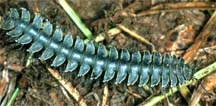 |
Gonzalo Giribet Museum of Comparative Zoology Harvard University, 16 Divinity Avenue Cambridge, MA 02138, USA ggiribet@oeb.harvard.edu |
Hemiptera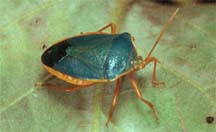 |
Harry Brailovsky Departamento de Zoología, Instituto de Biología, U.N.A.M. Circuito Exterior s/n, Ciudad Universitaria, Copilco, Coyoacán A.P. 70-233 México, Distrito Federal. C.P. 04510 coreidae@ibiologia.unam.mx |
Coleoptera |
Zachary Falin Division of Entomology, KUNHM/BRC Snow Entomological Collection 1501 Crestline Dr. Suite 140 University of Kansas Lawrence, Kansas 66049 ksem@ku.edu |
Diptera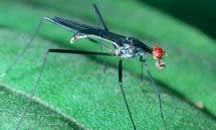 |
Steve Marshall Department of Environmental Biology University of Guelph Guelph, ON, Canada, N1G 2W1 smarshal@uoguelph.ca |
Hymenoptera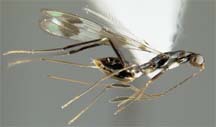 |
Michael Sharkey Department of Entomology S-225 Ag. Sci. North University of Kentucky Lexington, KY 40546-0091, USA msharkey@uky.edu |
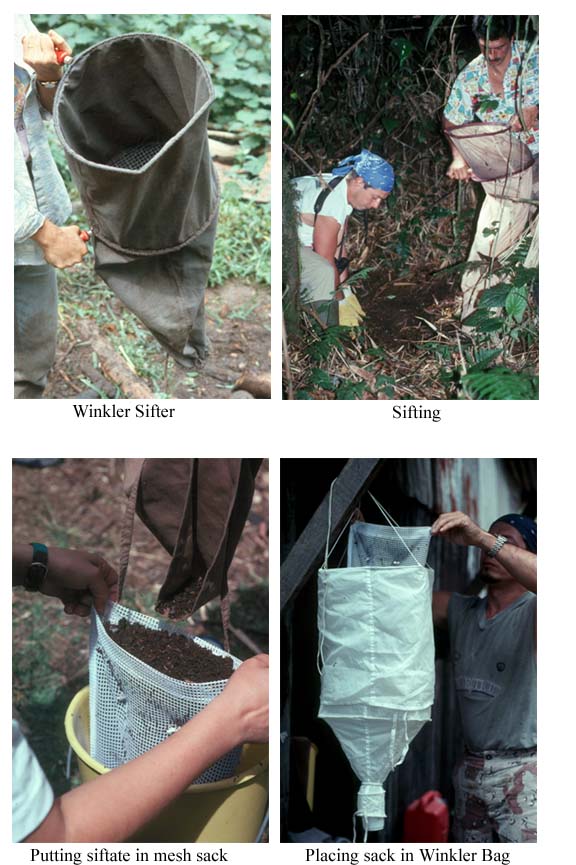
Winkler samples are an efficient method of sampling leaf litter ants. The method involves sifting bulk samples of leaf litter and rotten wood by agitating them vigorously in a bag above a coarse mesh screen. Litter arthropods are concentrated in the finer "siftate" that passes through the screen. Arthropods are then extracted from the siftate by a passive extraction method, in which the siftate is placed in thin mesh sacks and then suspended and enclosed within an outer cloth "Winkler bag." The Winkler bag tapers to a cup of ethanol. After loading the sample the Winkler bag is closed at the top and suspended in a sheltered location. Arthopods fall from the litter and accumulate in the ethanol, and the sample is taken off after 3 days.
Methodological variations involve how the bulk litter is selected. A "MaxiWinkler" sample involves a subjective selection of litter to sift, and is not based on a particular area or volume of bulk litter. The person taking the sample moves through the habitat selecting pockets of moist litter. These accumulations of litter and rotten wood occur between buttresses, along the sides of rotten logs, around dead stumps, and in soil depressions. When approximately 6l of siftate is obtained, the material is placed in a cloth bag and returned to the lab or field camp to be suspended in a Winkler bag.
A "miniWinkler" sample involves sifting the litter from a one square meter quadrat. The litter and dead wood in the quadrat are first aggressively minced with a machete. Then the litter is sifted until all the litter in the quadrat is sifted or 2l of siftate are obtained, whichever comes first. When there is more than enough litter to produce 2l of siftate, the different kinds of litter in the quadrat (e.g. leaves on soil versus litter from a rotten log) are subsampled so that all are represented (a somewhat subjective process that attempts to include the diversity of litter types found in the quadrat). Quadrats are placed according to a protocol of transects, grids, stratification, randomization, or other procedures. Thus the method is much less subjective and less dependent on the habits of the sifter. However, miniWinkler samples are less efficient than maxiWinklers in terms of species capture per unit of effort.
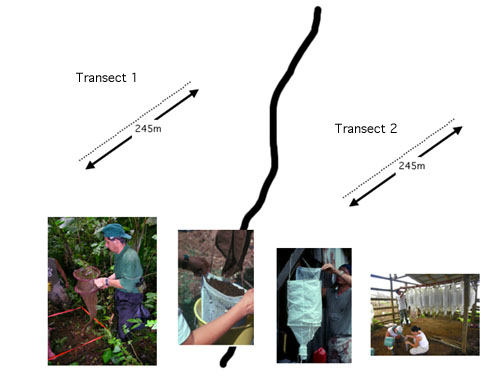
At each field site two transects of miniWinkler samples will be taken. Each transect will be 245m long and contain 50 quadrats at 5m spacing. Starting point and direction of transect will be chosen subjectively, attempting to keep the transect within a habitat patch. If the patch is too small, or an impassable area is encountered, the transect may change direction or be broken into more than one segment.
Longino, J. T. and R. K. Colwell. 2011. Density compensation, species composition, and richness of ants on a neotropical elevational gradient. Ecosphere 2:art29. [pdf]
Esteban Duran, J. R., A. Santos-Silva. 2011. A new species of Echthistatus Pascoe, 1862 and considerations on synonymy of Edechthistatus Monné, 2006 (Coleoptera, Cerambycidae). Spanish Journal of Agricultural Research 2011 9(1), 100-107.
Laurance, W. F., et al. 2011. Global warming, elevational ranges and the vulnerability of tropical biota. Biological Conservation 144:548-557.
Anderson, R. S. 2010. A taxonomic monograph of the Middle American leaf-litter inhabiting weevil genus Theognete Champion (Coleoptera: Curculionidae; Molytinae; Lymantini). Zootaxa 2548:1-127. [contact author for pdf]
Brailovsky, H. 2010. A new genus and two new species of Antillocorini (Hemiptera: Heteroptera: Rhyparochromidae: Rhyparochrminae) from Mexico and Guatemala. Zootaxa 2717:62-68.
Koch, M., G. D. Edgecombe, and R. M. Shelley. 2010. Anatomy of Ectonocryptoides (Scolopocryptopidae: Ectonocryptopinae) and the phylogeny of blind Scolopendromorpha (Chilopoda). International Journal of Myriapodology 3:51-81.
Longino, J. T. 2010. A taxonomic review of the ant genus Megalomyrmex Forel (Hymenoptera: Formicidae) in Central America. Zootaxa 2720:35-58.
Longino, J. T. 2010. Biodiversity mapping: the ‘John Gould’ component of tropical biology. Biotropica 42:543-545.
McNett, K., J. Longino, P. Barriga, O. Vargas, K. Phillips, and C. L. Sagers. 2010. Stable isotope investigation of a cryptic ant-plant association: Myrmelachista Ŗavocotea (Hymenoptera, Formicidae) and Ocotea spp. (Lauraceae). Insectes Sociaux 57:67-72.
Platnick, N. I. & N. Duperre. 2010. The goblin spider genus Scaphiella (Araneae, Oonopidae). Bulletin of the American Museum of Natural History 332:1-156.
Weiser, M. D., et al. 2010. Canopy and litter ant assemblages share similar climate-species density relationships. Biology Letters 6:769-772.
Brailovsky, H. 2009. Longinischus ornatus, a new genus and new species of Ozophorini (Hemiptera: Heteroptera: Lygaeoidea: Rhyparochromidae: Rhyparochrominae) from Guatemala. Zootaxa 2292:65-68.
Brailovsky, H. and L. Cervantes P. 2009. New genus and three new species of leaf-litter-inhabiting Ozophorini (Hemiptera: Heteroptera: Lygaeoidea: Rhyparochromidae: Rhyparochrominae). Annals of the Entomological Society of America 102:959-963.
Branstetter, M. G. 2009. The ant genus Stenamma Westwood (Hymenoptera: Formicidae) redefined, with a description of a new genus Propodilobus. Zootaxa 2221:41-57.
Longino, J. T. 2009. Additions to the taxonomy of New World Pheidole (Hymenoptera: Formicidae). Zootaxa 2181:1-90.
Quinet, Y., R. Hamidi, M. X. Ruiz-Gonzalez, J.-C. de Biseau, and J. T. Longino. 2009. Crematogaster pygmaea (Hymenoptera: Formicidae: Myrmicinae), a highly polygynous and polydomous Crematogaster from northeastern Brazil. Zootaxa 2075:45-54.
Kumar, A., J. T. Longino, R. K. Colwell, and S. O'Donnell. 2009. Elevational patterns of diversity and abundance of eusocial paper wasps (Vespidae) in Costa Rica. Biotropica 41:338-346.
Longino, J. T., D. J. Cox. 2009. Pheidole bilimeki reconsidered (Hymenoptera: Formicidae). Zootaxa 1985:34–42.
Astrin, J. J., and P. E. Stüben. 2008. Phylogeny in cryptic weevils: molecules, morphology and new genera of western Palaearctic Cryptorhynchinae (Coleoptera : Curculionidae). Invertebrate Systematics 22:503–522.
Colwell, R. K., G. Brehm, C. L. Cardelus, A. C. Gilman, and J. T. Longino. 2008. Global warming, elevational range shifts, and lowland biotic attrition in the wet tropics. Science 322:258-261.
Herrera, H., J. T. Longino. 2008. New records of introduced ants (Hymenoptera; Formicidae) in the Galapagos Islands. Galapagos Research 65:16-19.
Adams, R. M. M., and J. T. Longino. 2007. Nesting biology of the arboreal fungus-growing ant Cyphomyrmex cornutus and behavioral interactions with the social-parasitic ant Megalomyrmex mondabora. Insectes Sociaux 54:136-143.
Longino, J. T. 2007. A taxonomic review of the genus Azteca (Hymenoptera: Formicidae) in Costa Rica and a global revision of the aurita group. Zootaxa 1491:1-63.
Longino, J. T., and F. Fernández C. 2007. A taxonomic review of the genus Wasmannia. Pages 271-289 in R. R. Snelling, B. L. Fisher, and P. S. Ward, editors. Advances In Ant Systematics (Hymenoptera: Formicidae): Homage To E. O. Wilson – 50 Years Of Contributions. Memoirs of the American Entomological Institute, 80.
Dunn, R. R., N. J. Sanders, M. C. Fitzpatrick, E. Laurent, J.-P. Lessard, D. Agosti, A. N. Andersen, C. Bruhl, X. Cerda, A. M. Ellison, B. L. Fisher, H. Gibb, N. J. Gotelli, A. Gove, B. Guenard, M. Janda, M. Kaspari, J. T. Longino, J. Majer, T. P. McGlynn, S. B. Menke, C. L. Parr, S. M. Philpott, M. Pfeiffer, J. Retana, A. V. Suarez, and H. L. Vasconcelos. 2007. Global ant (Hymenoptera: Formicidae) biodiversity and biogeography – a new database and its possibilities. Myrmecological News 10:77-83.
Longino's database of over 87,000 species occurrences in over 2200 species has been integrated with AntWeb at the California Academy of Sciences, providing fully georeferenced specimen data available for browsing on Google Earth.
Longino continues to develop the Pheidole working group. Web-based resources include a complete taxonomic catalogue in the form of a down-loadable parsed Excel file, an illustrated glossary of morphology, and a Lucid key to the nearly 700 New World Species.
Longino's Ants of Costa Rica website continues to grow and improve, the latest addition being a treatment of the genus Azteca.
 |
This work is supported by National Science Foundation grant DEB-0640015, Biodiversity Surveys and Inventories Program. Any publications that rely on the LLAMA project for specimens or other forms of support should include a statement to that effect, with the grant number, in the Acknowledgments. Please send the full bibliographic reference of any such publications, preferably in a form that can be imported into EndNote, to John T. Longino longinoj@evergreen.edu. |
This web site is based upon work supported by the National Science Foundation grant DEB-0640015.
Any opinions, findings and conclusions or recommendations expressed in this material are those of the author(s) and do not necessarily reflect the views of the National Science Foundation (NSF).